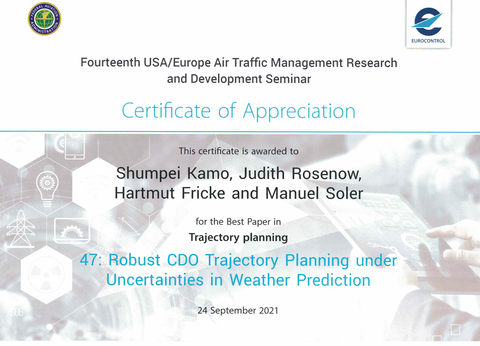CDO-Speedbrakes: Optimized CDO under uncertain environmental and mission conditions
Project information
- Funded by DFG
- Original project runtime 3 years (2018 - 2021)
- The runtime was extended for another year (2021 - 2022)
The project “CDO Speedbrakes” aims at providing pilots with advice about the best and the second-best CDO (Continuous Descent Operation) trajectories and estimating how much fuel consumption and emissions would be reduced. A descent trajectory is both spatially and temporally affected by uncertain disturbances and errors, which are hardly predictable. In this project, models will be developed to describe these uncertain disturbances and their impact on CDO trajectory calculation. Such models will allow more accurate trajectory calculation and will avoid undesirable level flight segments, as shown in the picture, which are often inevitable in today’s operation.
Furthermore, the second-best CDO trajectories will also be modeled. They can be regarded as alternative options for the pilots. These alternative solutions will ensure that the flight efficiency will be improved even if the optimum CDO trajectory cannot be performed or is refused by the air traffic controller.
The final goal of the project is to visualize the developed descent advice on a cockpit instrument and evaluate it with our A320 flight simulator.
CDO-Speedbrakes is a collaborative research project together with the chair of economics and statistics, esp. in the transport sector, TU Dresden.
Continuous Descent Operations (CDO) are one of the key objectives of major global projects for further development of the Air Traffic Management (ATM) system invented by the “Single European Sky ATM Research Programme (SESAR)” in Europe, the “Next Generation Air Transportation System (NextGen)” in the United States and the “Collaborative Actions for Renovation of Air Traffic Systems (CARATS)” in Japan. According to the ICAO Doc. 9931, the CDO is a flight operation method that enables an optimum flight trajectory in terms of minimum engine and air-drag configurations (gliding flight). The optimum flight trajectory normally describes a continuous descent from the Top of Descent (ToD) to a Fix Point, such as the Initial Approach Fix (IAF) or the Final Approach Fix (FAF). Furthermore, level flight segments are avoided in order to reduce increased fuel consumption at non optimum altitudes and emissions.
Previous investigations showed however that the benefits of the CDO had not yet been entirely achieved. Implementation of the optimum CDO trajectory is usually hardly possible as it is affected by uncertain input and disturbance variables (e.g. wind, ambient temperature, human factors, aircraft weight). Access to highly accurate and robust models and data is of great significance for trajectory-based operations. However, such uncertainties have not yet been so precisely modeled as being sufficient to predict accurate and robust optimum CDO trajectory. Especially, interferences between uncertain variables (e.g. wind interferes with temperature) pose a great challenge. Therefore, investigations should be undertaken to stochastically model these uncertain variables for the trajectory optimization.
We also need to consider operational situations in which the exact spatial and temporal location of the optimum ToD cannot be calculated due to the uncertainties of the affective variables in the coming descent flight phase. In these cases, advices will be developed for the pilots and the air traffic controllers being able to decide on starting the descent “quite early” or “late”. Descent that is early initiated (prior to the “optimum” ToD) may require horizontal flight segments. On the other hand, late descent requires the use of speed brakes or detours to break down the excess kinetic energy and reduce the aircraft’s speed. However, this will increase fuel consumption and will emit exhaust and noise. We need to study on what path the aircraft should fly in those situations and how much the ecological and environmental impact will be caused. We call this alternative robust solutions “the second best solution”.
A 4-D solution space containing all possible descent trajectories including the optimum CDO trajectory and the second best solution will be methodically calculated based on stochastic modeling of the uncertain input and disturbance variables. The project’s long-term aim is to visualize the calculated solution space on our GUI called “Improved Descent Advisor (IDA)” to help pilots and air-traffic controllers make decision. Finally, the solutions will be tested using our A320 and air traffic simulators to evaluate their feasibility and the resulting overall efficiencies.
Another goal is to implement the knowledge of this project into our aircraft performance model called “COmpromised Aircraft performance model with Limited Accuracy (COALA)” in order to enhance its model for descent flight phase.
Shumpei Kamo, Judith Rosenow, Hartmut Fricke and Manuel Soler. Robust Optimization Integrating Aircraft Trajectory and Sequence under Weather Forecast Uncertainty . Transportation Research Part C: Emerging Technologies. vol. 152, p. 104187, 2023, doi: https://doi.org/10.1016/j.trc.2023.104187
Judith Rosenow, Thomas Sachwitz, Shumpei Kamo, Gong Chen and Hartmut Fricke. Aircraft-Type-Specific Impact of Speed Brakes on Lift and Drag. Aerospace. 2022; 9(5):263, doi: https://doi.org/10.3390/aerospace9050263
Shumpei Kamo, Judith Rosenow, Hartmut Fricke and Manuel Soler. Fundamental Framework to Plan 4D Robust Descent Trajectories for Uncertainties in Weather Prediction. Aerospace. 2022; 9(2):109, doi: https://doi.org/10.3390/aerospace9020109
Shumpei Kamo, Judith Rosenow, Hartmut Fricke and Manuel Soler. Robust CDO Trajectory Planning under Uncertainties in Weather Prediction, 14th USA/Europe Air Traffic Management Research and Development Seminar (ATM Seminar), 2021 *Best paper award in track
Shumpei Kamo, Judith Rosenow and Hartmut Fricke. CDO Sensitivity Analysis for Robust Trajectory Planning under Uncertain Weather Prediction, 39th Digital Avionics Systems Conference (DASC), 2020
Gong Chen and Ostap Okhrin. Interpolation of Weather Conditions for a Flight Corridor, Statistische Woche 2019, Tier
Best paper award in track, 14th USA/Europe Air Traffic Management Research and Development Seminar (ATM Seminar), 2021


